Macau is a vibrant city on a peninsula of China. Four and a half centuries of Portuguese rule have left their mark with a quaint downtown, narrow cobbled streets, an old fort and many churches. There is a good mix between Portuguese and Chinese culture to be found.
After the handover to the Chinese in 1999, the area became known as the Macau Special Administrative Region (SAR). Since then, there has been a large increase in casinos in Macau. It is now the gambling paradise of the world; rumour has it that there is even more money gambled than in Las Vegas! This is largely to do with the new Cotai strip, with its huge mega-casinos on the manmade “islands” of Taipa and Coloane.
Macau is easily accessible, without a visa and only one hour by fast ferry from Hong Kong.
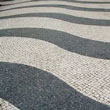 Largo do Senado:
Largo do Senado:
This large square, some 3700m2, is paved with a impressive wave-patterned mosaic of black and white coloured stones, created by Portuguese experts, similar to the Praça de Rossio and the floor around the Padrão de Descubrimentos in Lisbon.
Address: Largo do Senado
.
.
.
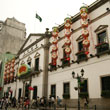 Leal Senado:
Leal Senado:
Means Loyal Senate, thanks to Macau not recognising the Spanish occupation of Portugal in the 17th century. The centrepiece of the square (and the city), is the Leal Senado, a beautiful white building, with green windows, iron balconies, and flowers hung across, the front. It was built in 1784, and the building where the Portuguese planned their conquest of Asia, which never materialised due to earlier mentioned Spanish occupation back home. Today, it houses the Mayor’s Office, and a public library.
Address: 163, Avenida de Almeida Ribeiro
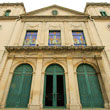 Sé – Cathedral of Macau:
Sé – Cathedral of Macau:
This cathedral is the main cathedral of Macau, and the mother church of the catholic Diocese of Macau. Due to the Sjanghai plaster, the building is grey on the outside and can therefore appear a little plain compared to the other churches in Macau. The inside is also understated with white and pastel colours.
Address: Largo da Sé
.
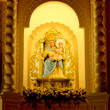 Igreja do São Domingos:
Igreja do São Domingos:
This seventeenth century Baroque church in Largo São Domingos (St Dominic’s Square), is said to be one of the most beautiful church in Macau. It is certainly one of the best kept. The outside is plastered yellow with green shutters.
Address: Largo do São Domingos
.
.
.
 Ruinas de São Paulo – Ruins of St. Pauls:
Ruinas de São Paulo – Ruins of St. Pauls:
This standing façade, with the foundations of the College of St. Pauls behind it, and the 66 steps leading up to it, used to be the largest catholic cathedral in Asia, the Mater Dei. Sadly, a fire following a typhoon burnt it to the ground in 1835, and now only the façade remains. Restauration completed in 1995, and in 2005 it was offically enlisted as part of the UNESCO World Heritage Site of the Historic Centre of Macau.
Tip: Do like the locals and throw coins into the top window of the ruins from the stairs, for luck.
Address: Rua do São Paulo
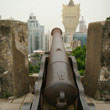 Fortaleza do Monte:
Fortaleza do Monte:
The fort was constructed at the same time as the Mater Dei (what is now the Ruins of St Pauls, see above) from 1617 to 1626 as the city’s main military defence structure. There were cannons, military barracks, wells and an arsenal with sufficient ammunition and supplies to endure a siege lasting up to two years. The fortress has the shape of a Trapezoid, and covers an area of 10,000 m2. Inside you can find the Macau Museum.
Address: Fortaleza do Monte
.
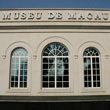 Macau Museum:
Macau Museum:
This Museum is built within the Fortaleza do Monte. The museum was opened on 18 April 1998 with total size is about 2,800 m2, with around 2,100 m2 of exhibition space.
Address: Fortaleza do Monte
.
.
.
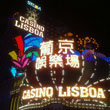 Casino Lisboa and Grand Lisboa:
Casino Lisboa and Grand Lisboa:
The Casino Hotel Lisboa is one of the original and most well known casinos of Macau and Asia. The original casino was only three stories high built in the late ’60s. Nowadays, a huge casino and hotel with over 400 rooms has been built right accross from it, the Grand Lisboa, one of the landmarks of the Macau skyline.
Link: Casino Lisboa
Link: Grand Lisboa
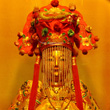 A-Ma Temple:
A-Ma Temple:
The A-Ma temple can be found on the South of the Macau Peninsula. Not only is it one of the oldest Taoist temples in Macau, it is arguably the most famous. It was built in 1488, in reverence of Matsu, the Godess of seafarers and fishermen (in Hong Kong referred to as Tin Hau). Legend has it that when the Portuguese sailors landed just outside the temple and asked the name of the place, the natives replied “Maa Gok”, another name given to the same deity. The Portuguese then named the peninsula “Macao” hereafter.
Address: Rua de São Tiago da Bara
 Macau Tower:
Macau Tower:
The Macau Tower, or Macau Tower Convention & Entertainment Centre as it is known officially, measures 338 m (1,109 ft) in height from ground level to the highest point. There is an observation deck with panoramic views, restaurants, theaters, shopping malls and the Skywalk X, a thrilling walk around the outer rim. From here, you have the best views of Macau. Recently, some adventures have been added, such as the Macau Tower’s “skyjump” and Bungee jump by AJ Hackett. From the tower’s outer rim, with 233 metres, this is the second highest commercial skyjump in the world.
Link: Macau Tower
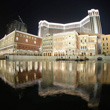 Cotai Strip:
Cotai Strip:
The Cotai Strip is the manmade landmass between the Coloane and Taipa islands (Hence Cotai), where the megastructure casinos and tourism hotels are built, inspired by the Las Vegas Strip in Nevada, USA. Conceived by the Sands corporation, there will be somewhere over 20,000 hotel rooms, with casinos, entertainment and huge shopping malls, along this piece of land. The Venetian Macau, built after the Venetian in Las Vegas, was the first hotel to open its doors on the Cotai Strip.
Link: Venetian Macau

